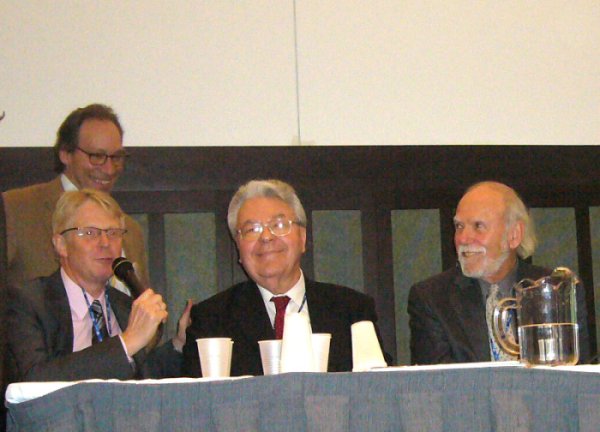Director's Corner
21 February 2008
 Barry Barish |
Contemplating large international collaborations
The American Association for the Advancement of Science (AAAS) annual meeting took place from 14 to 18 February in Boston, US, under the theme "Science and Technology from a Global Perspective." The AAAS is the meeting ground for the broad range of sciences in the US, from biology to physics. This association also publishes the very famous weekly journal Science. In the spirit of the conference theme, Lawrence Krauss, Case Western Reserve University, and Maria Spiropulu, CERN, organised a very provocative and interesting special session entitled, "Large-Scale International Collaborations and the Future of Physics."
Leaders of six international collaborations talked about their experiences - including Robert Aymar for CERN and the Large Hadron Collider (LHC), myself for the International Linear Collider (ILC), Norbert Holtkamp for ITER, a large-scale international fusion effort, John Mather, co-recipient of the 2006 Nobel Prize in Physics, for the James Webb Space Telescope and Anneila Sargent for the Atacama Large Millimeter/submillimeter Array (ALMA), an international astronomy collaboration. Finally, Steve Chu, Director of Lawrence Berkeley National Laboratory and co-winner of the 1997 Nobel Prize in Physics talked about physicists' roles and challenges for global issues of energy concerns. The subject matter spanned broad frontier areas of physics and astronomy, the nature of each international collaboration and the unique challenges and opportunities in each project.
In his talk, Robert Aymar described three models for international collaboration. According to him, the first model is based on "individual interest" and is the traditional way we do science internationally, by carrying out experiments and theoretical work jointly by collaborations extending across state and country borders.
The second model that Aymar presented is essentially the CERN model for the LHC and its experiments. He called this a model based on "collective interest." It involves a group of collaborating entities with a unique host (for example CERN). The projects (for example LHC experiments) are developed, built and run through an international collaboration that is run by consensus, but where success is shared or backed up by the host. Norbert Holtkamp pointed out that although ITER is also organised around a host model, the collaboration is almost entirely based on in-kind contributions, making the task of providing coherent central coordination particularly challenging.
The final model Aymar presented he called the "equipartition model" - his "dream" model. A simple extension of the "collective interest" model, it has no host site, and therefore all members give equal contributions, take equal responsibility and receive equal rights. Interestingly, Anneila Sargent described ALMA as being organised in a way not so different from the third model, because the host country (Chile) does not play the strong central role. Also, clearly the James Webb Space Telescope as presented by John Mather is an international partnership without a physical host location, although the partners' contributions are not be fully equal.
It is interesting to contemplate how the linear collider fits into these schemes at present and in the future. For the ILC, a particularly important feature of the present global collaboration is that there is no host and therefore we have organised ourselves very much in the spirit of Aymar's "dream model," in that the work and decisions are being made by consensus on a global basis. This makes it possible for us to develop the design jointly, resulting in full joint "ownership" of all aspects of the design by our partners. I think that this gives us a unique strength for the future. It is much more difficult to establish such complete joint ownership for a project that is initiated from a host laboratory and then adds outside partners. R&D for the CLIC higher energy option for a linear collider is being pursued through CERN, as host laboratory, and has recently actively pursued expanding the collaboration internationally.
Of course, the ILC will need to have a strong host laboratory for it to become a reality, and our model of international partnership will need to adapt to that reality. The addition of a strong host will assure successful implementation, and hopefully in our case we will be able to do that in a way that will maintain the global ownership, commitment and responsibility that we have been building for the ILC. A strong host and true international ownership and commitment will make a powerful combination to take on the challenge of building a linear collider.
-- Barry Barish
